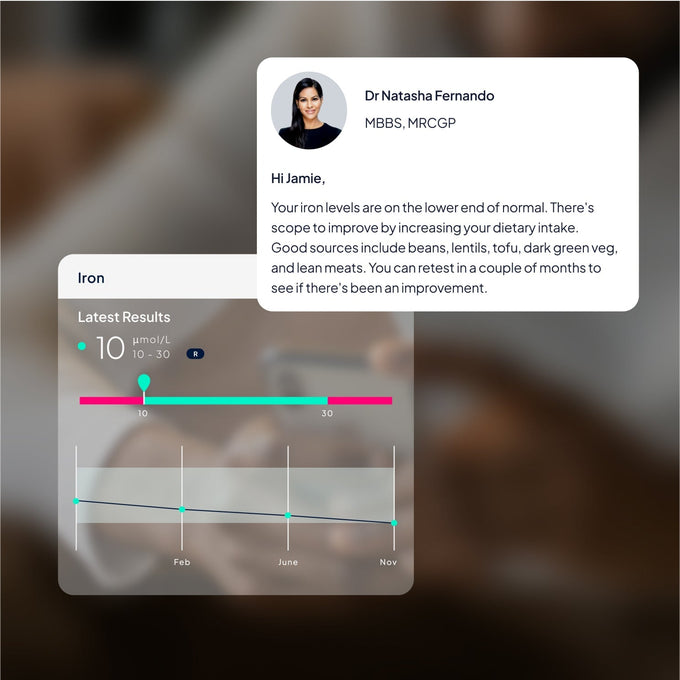If you're noticing thinning hair or excessive shedding, this test can help uncover potential causes. Hair loss can be linked to hormonal imbalances, nutritional deficiencies, or underlying health conditions. By measuring key markers related to thyroid function, iron levels, and hormone balance, this test provides valuable insights to help you take control of your hair health.




Hair Loss Blood Test
- Results estimated in 7 working days
- Convenient testing options
- Bespoke doctor’s report
- Free delivery
Includes thyroid function, inflammation, iron status, vitamin D, and key hormones to assess potential causes of hair loss.
How do you want to take your sample?
Please choose one option below-
Collect your own finger-prick blood sample at homeFreeWe’ll send you everything you need to collect your blood sample from your finger at home.
-
Book a venous draw at a clinic Venous+£35Visit one of our national clinic partners for a nurse to take your venous blood sample from a vein in your arm. We’ll email you instructions on how to book after we’ve processed your order.
-
Book a venous draw at home with a nurse Venous+£59Book a home nurse appointment for a nurse to take your venous blood sample from a vein in your arm.
-
Self-arrange a professional sample collection VenousFreeMake an appointment at a phlebotomy clinic to have your venous blood sample taken. You will be responsible for arranging your appointment and any additional fees.
18+ Only. T&Cs apply.
Find your nearest clinic

Go beyond the numbers
Get ready to elevate your health understanding with a personalised doctor's report. Go beyond results and tap into expert insights tailored just for you.
- Actionable advice
- Expert support
- Tailored recommendations

How it works
You have the flexibility to choose what works best for you. Enjoy the comfort of having a friendly nurse visit your home for a quick blood draw, opt for a convenient visit to one of our nationwide partner clinics, or self-arrange a draw at a location that suits you.
Take control of your health with Medichecks – order your blood test today!

Track, improve, and monitor your health over time.
MyMedichecks is your personal online dashboard where you can view your results, access clear and simple explanations about individual health markers, monitor changes in your health, and securely store information about your medical history, lifestyle and vital statistics.
Supported by a team of specialist and qualified doctors
Dr Natasha Fernando
Medical DirectorDr Tina Ghela
Digital Clinician LeadDr Susanna Hayter
Digital Clinician
What's in the test?
Hormones
Testosterone
Learn more
Free androgen index
Learn more
Inflammation
hs-CRP
Learn more
Iron status
Ferritin
Learn more
Proteins
SHBG
Learn more
Thyroid hormones
TSH
Learn more
Free thyroxine
Learn more
Vitamins
Vitamin D
Learn more
Despite its name, vitamin D is actually a hormone that’s produced by your skin when it’s exposed to sunshine. Before your body can use vitamin D produced by sun exposure (known as vitamin D3), it must be converted into another form called 25 hydroxycholecalciferol (25 OH). Vitamin D (25 OH) is the major circulating form of vitamin D, and so your vitamin D (25 OH) level is considered the most accurate indicator of vitamin D supply to your body.
Vitamin D is essential for healthy bones and teeth, as it helps your body absorb calcium. It also plays a role in muscle health, immune function, and mental health.
Low vitamin D symptoms include muscle weakness, mood swings, and fatigue. Many people in the UK have low vitamin D levels, and people with dark skin and people who don’t spend much time outdoors are particularly at risk.
Small amounts of vitamin D can be obtained from food, especially oily fish, eggs, and vitamin-D fortified foods. But if you have a vitamin D deficiency, you’re unlikely to be able to improve your levels by food alone.
How to prepare for your test
Prepare for your Hair Loss Blood Test by following these instructions. Take your sample between 6am and 10am. Take this test when any symptoms of short-term illness have settled. Avoid taking a finger-prick sample from a finger used to apply hormone gels/pessaries/patches in the past 4 weeks. Use gloves to apply these. Take your sample at least 24 hours after any vitamin or mineral supplements. Do not take biotin supplements for two days before this test, discuss this with your doctor if it is prescribed. If you take thyroxine, you can take your medication as usual, either before or after your blood test. However, if you take desiccated thyroid extract (DTE) or liothyronine, it's best to take it after you've collected your sample. Please let us know in your supporting information if you take amiodarone or lithium as these can affect your thyroid function results.
Test limitations
This test identifies possible contributors to hair loss but does not diagnose specific conditions such as alopecia.
Reviews
FAQs
What is a Hair Loss Blood Test?
Our blood test for hair loss lets you explore some specific health issues that could be to blame for hair loss or thinning.
It checks your thyroid hormones levels, which can indicate whether you have an underactive or overactive thyroid — both conditions can cause hair thinning. It also checks your ferritin level (iron store), as low iron is another possible cause.
Conversely, raised ferritin levels may indicate an inflammatory disorder, which could be affecting your hair growth. Our hair loss test includes an inflammatory marker (hs-CRP) to check whether this is likely.
Our test also checks your free testosterone level, as a high level of testosterone can contribute to hair loss in males. In females, hair loss is more likely to be caused by a hormonal imbalance where there’s excess androgens (a class of hormones that includes testosterone).
What causes hair loss?
There are many reasons for hair loss. The most common is genetics — this is known as hereditary male or female pattern baldness. This can happen at any life stage but is more common with age.
Occasionally, hair loss can be the sign of a medical issue. These include autoimmune conditions (like a thyroid disorder, lupus, alopecia areata, or Crohn’s disease), hormone imbalances, and micronutrient deficiencies, such as low iron.
Other causes of hair loss include stress, illness, drug side effects, overstyling, and regularly applying chemicals to your hair, such as hair dye.
If you’re experiencing hair thinning or loss in addition to other symptoms, we recommend you see your GP.
How much hair loss is normal?
Shedding hair is a normal part of life. On average, we have around 100,000 hair follicles on our heads and lose between 50–100 hairs per day, as part of the hair’s natural growth cycle.
Hair loss isn’t normally anything to worry about, but if you’re concerned about the amount of hair you’re losing, a blood test is a great first step to begin investigating possible causes.
How can I prevent hair loss?
This depends on the cause. Some types of hair loss are permanent, like male and female pattern baldness. This type of hair loss usually runs in families.
Other types of hair loss may be temporary, such as hair loss caused by stress, an illness, cancer treatment, or weight loss, and normally goes away as your body recovers from the trigger event.
Which vitamin and mineral deficiencies can cause hair loss?
Iron deficiency can cause hair loss and is more common in women who have periods, people with anaemia, and people who follow a plant-based diet.
Adding iron-rich foods to your diet may help to prevent hair loss if you find your iron level is below the normal range. And your doctor may recommend supplements if you have iron deficiency anaemia.
Healthy levels of riboflavin, biotin, B12, folate, selenium, zinc, vitamin D, and magnesium are also important for healthy hair.
Does testosterone cause hair loss in males?
The relationship between hair loss and testosterone is complicated. Testosterone itself doesn’t directly cause hair loss. It’s the action of dihydrotestosterone (DHT) — a hormone made from testosterone — that can affect hair follicles leading to hair loss.
It’s not the amount of DHT that causes hair loss, it’s the sensitivity of the hair follicles to DHT. And that sensitivity is determined by genetics. Age, stress, and other factors can also play a part, but if you’re male and have a close male relative with male pattern baldness, you’re more likely to develop it too.
Is hair loss more common in men than women?
Hair loss is more common in males than females. It also tends to follow a different pattern. Genetic male pattern baldness typically begins with a receding front hairline and a bald spot at the crown of the head, while women tend to experience diffuse hair loss across the scalp.
It’s thought that as men constantly produce testosterone throughout their lives, they’re more likely to experience hair loss. For women, hormonal changes may lead to excess shedding, with many women noticing their hair thinning around menopause and after childbirth.
What can I do if my hair loss is affecting my wellbeing?
Hair loss and thinning can be upsetting. For many people, their hair is an important part of their identity.
If hair loss or thinning is affecting your mental health, we recommend that you seek help from your GP. You may also benefit from joining support groups and online forums, where you can talk to other people going through the same experience.
Can I take a Hair Loss Blood Test at home?
Yes, you can take our hair loss test at home. We’ll send you everything you need including a finger-prick test kit and a return envelope for your sample.
Why have the male reference ranges for testosterone changed?
The reference range for testosterone has been adjusted to have a lower limit of 12 nmol/L to reflect guidance from the British Society for Sexual Medicine (BSSM) 2022.
Our medical advice regarding testosterone levels remains the same and we advise that if your total testosterone level is between the range of 8-12 nmol/L and you have symptoms of low testosterone you may be considered eligible for testosterone replacement therapy. If your testosterone level falls within this range but you have no symptoms this is considered satisfactory and no further action is required.
